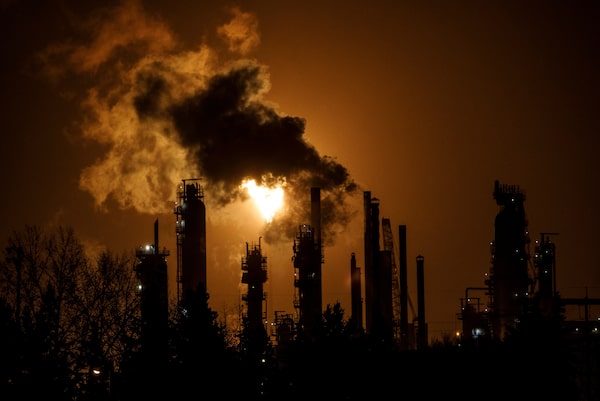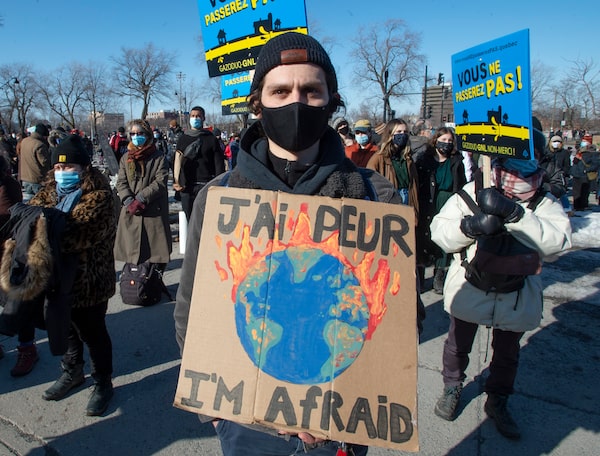Get caught up on the basics of carbon pricing with our video explainer.
The Globe and Mail
Climate change has already begun, and it’s a threat to Canadians’ ways of life as extreme weather gets more common and less predictable, sea levels rise and important species of plants and animals die out. Cutting our emissions quickly and soon can mitigate the damage, and dozens of countries have pledged to do this.
On April 1, 2022, the federal carbon tax will go up another $10 per tonne, up to a total of $50 per tonne of emissions. The increase will also add another 2.2 cents to the cost of a litre of gasoline, or 11 cents total.
The Trudeau government introduced a national carbon-pricing regime in 2019 to encourage individual Canadians and industry to switch to greener habits. On Thursday, the Supreme Court upheld Ottawa’s right to impose it on provinces whose climate plans didn’t meet federal standards.
Here’s what you need to know about how carbon pricing works and what it means for you.
What is carbon pricing? What is a carbon tax?
Carbon pricing means charging a minimum cost for fossil fuels like gasoline, diesel and coal, and the goods made from them, so that their prices come closer to the real environmental costs. This can be applied either as a tax on goods produced or sold, or as carbon permits that corporations can trade on a regional market (we’ll get into the difference in more detail later).
How much is Canada’s carbon price?
For consumers, the federal minimum price started at $20 per tonne of CO2 equivalent in 2019. It will be $50 in the spring of 2022, increasing by $15 annually until it reaches $170 in 2030. Participating provinces and territories set their own taxes that meet or exceed that standard, or use a cap-and-trade system that achieves the same result. If a province has no plan, or if it’s below the standard, the federal government applies a “backstop” that applies the minimum price through federal taxes.
The federal levy applies directly in Alberta, Saskatchewan, Manitoba and Ontario but British Columbia, New Brunswick and Prince Edward Island are also raising their provincial carbon levies to stay in line. Quebec and Nova Scotia use cap-and-trade systems and Newfoundland and Labrador will raise its price to $50 a tonne later in 2022.
Carbon pricing’s costs and benefits to consumers
Not every province charges individuals equally for their carbon emissions, because not every province emits the same amount. But the system aims to offset most of the additional consumer costs through federal tax rebates, so that people with more fossil-fuel-intensive lifestyles have an incentive to change their habits and save money.
The federal government recently outlined the carbon price rebate amounts for 2022, which for the first time will be paid in installments rather than all at once. Only the four provinces directly involved in the federal system – Alberta, Saskatchewan, Manitoba and Ontario – receive the rebates, which are intended to prevent families from hurting financially for paying the carbon price while still having an incentive to save more money by using less greenhouse-gas emitting fuel.
The payments vary by province depending on the amount of fossil fuels used, and range from a low of $745 this year in Ontario, to $1,101 in Saskatchewan.
The carbon price Canadian businesses pay
Heavy industry has a different pricing system than the one for consumers. It measures how emissions-efficient a corporation is compared with its industry peers to decide how much it should pay. Alberta has a tax for big emitters that meets federal standards, even if its consumer tax system does not.
How emissions are measured
The federal framework sets a price per tonne of CO2 equivalent, a standard measurement of how much a substance increases the global greenhouse effect. For instance, putting one tonne of carbon dioxide into the atmosphere contributes to climate change by the same amount over 100 years as 40 kilograms of methane, or three kilograms of nitrous oxide. So different amounts of different substances will carry a different carbon price.
Watch: The emissions involved in your daily life are often expressed as a 'carbon footprint.' How big is the footprint for some activities in the home, like using a kettle versus streaming a television show? The International Energy Agency has a useful comparison, explained here.
What is cap-and-trade? What are carbon offsets?

A flare stack lights the sky from an oil refinery in Edmonton.Jason Franson/The Canadian Press
Taxing fuel and consumer goods is only one mechanism governments have to bring emissions down. There are two other important ones that the federal system currently allows, or will allow eventually, that are more complicated but have potential benefits that straight taxation doesn’t.
Cap and trade
In Quebec and Nova Scotia, the governments cap the amount of emissions they’ll allow each year, then hold quarterly auctions so companies can buy emissions credits within that amount. If a company wants to emit more than its credits allow, it has to buy credits from other companies that burn less. Quebec companies can trade credits with their counterparts in California, where emissions reduction is less expensive. The idea is that, each year, the provinces lower their caps and drive companies to emit less and less. If done well, this means the provinces have a more precise way to set the amount of emissions reductions they want to see overall, and then meet them. If done poorly, industry can game the system (such as by overreporting emissions) or governments can be seen to play favourites by picking winners and losers in the credit-allocation process.
Carbon offsets
A carbon offset is an investment in an emissions-reducing activity, like planting trees or building energy-efficient housing, that balances out an emissions-intensive activity. If you’ve flown a plane before, your airline may have offered you offsets like these. Offsets are controversial because there’s no globally accepted standard for them, and some environmental groups consider it a form of “greenwashing” that heavy emitters treat like a license to pollute. But Canada has long planned to create a domestic market for businesses, which will be a complicated balancing act to make sure the rules are fair, are strict enough that cheap and ineffective offsets don’t flood the market, but are not so strict that no one bothers to trade credits.
Is carbon pricing legal?

The statue representing justice looks out from the Supreme Court of Canada over the parliamentary precinct in Ottawa.Adrian Wyld/The Canadian Press
The Trudeau government had most provinces on board when it developed the carbon framework in 2018′s Greenhouse Gas Pollution Pricing Act, but some provinces elected new governments opposed to it, like Jason Kenney’s United Conservatives in Alberta or Doug Ford’s Progressive Conservatives in Ontario. Alberta, Saskatchewan and Ontario asked their appeal courts for a judgment on whether the act was constitutional: Alberta’s said no, Saskatchewan and Ontario’s said yes. Quebec, Manitoba and New Brunswick also intervened to oppose the law, while B.C. intervened in support.
The Supreme Court of Canada’s final decision was that the federal law is constitutional under the Constitution’s “peace, order and good government” clause, which gives the federal government jurisdiction over issues of “national concern.” Successful POGG claims are rare, but in the court’s 6-3 ruling, Chief Justice Richard Wagner wrote that Ottawa had met the threshold:
[Climate change is] a threat of the highest order to the country, and indeed the world. This context, on its own, provides some assurance that ... Canada is not seeking to invoke the national concern doctrine too lightly. The undisputed existence of a threat to the future of humanity cannot be ignored.
What’s the goal of carbon pricing?
To save the world, or at least to reduce our part in damaging it. Atmospheric CO2 has continued to reach record high concentrations, even after the COVID-19 pandemic brought much of the world’s air travel to a halt. The more the greenhouse effect accelerates, the sooner Canada will have to contend with disasters even worse than the ones it’s already faced, like intensifying wildfires in Western Canada, heavy spring floods in Quebec and Ontario and melting permafrost that drives northern communities into the sea. Canada’s pledge under the 2015 Paris agreement is to cut emissions by 30 per cent from 2005 levels by 2030, and to have net zero emissions by 2050.

Protesters take part in a demonstration calling for climate and social justice in Montreal.Ryan Remiorz/The Canadian Press
Compiled by Globe staff
With reports from Sean Fine, Bill Curry, Adam Radwanski and The Canadian Press
Our Morning Update and Evening Update newsletters are written by Globe editors, giving you a concise summary of the day’s most important headlines. Sign up today.